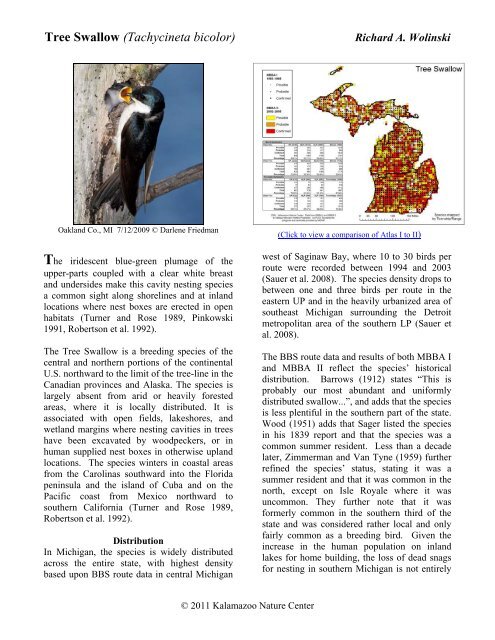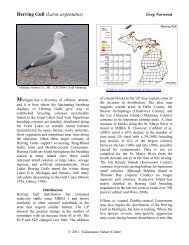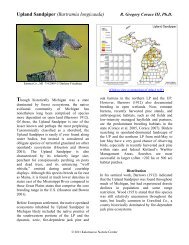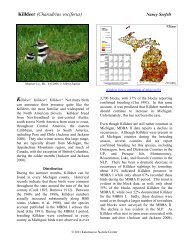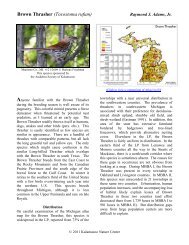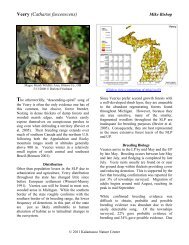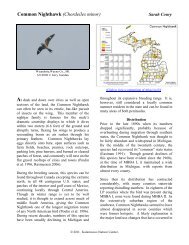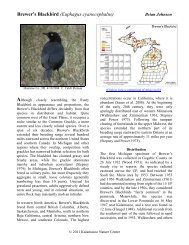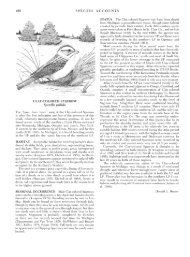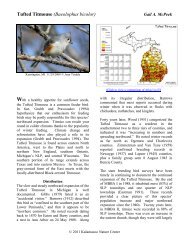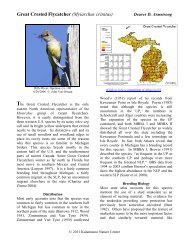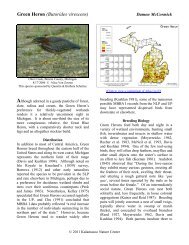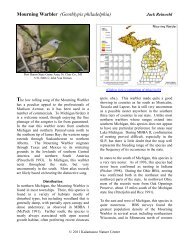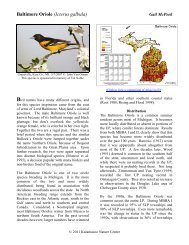Tree Swallow - Michigan Breeding Bird Atlas Website
Tree Swallow - Michigan Breeding Bird Atlas Website
Tree Swallow - Michigan Breeding Bird Atlas Website
You also want an ePaper? Increase the reach of your titles
YUMPU automatically turns print PDFs into web optimized ePapers that Google loves.
<strong>Tree</strong> <strong>Swallow</strong> (Tachycineta bicolor)<br />
Richard A. Wolinski<br />
Oakland Co., MI 7/12/2009 © Darlene Friedman<br />
The iridescent blue-green plumage of the<br />
upper-parts coupled with a clear white breast<br />
and undersides make this cavity nesting species<br />
a common sight along shorelines and at inland<br />
locations where nest boxes are erected in open<br />
habitats (Turner and Rose 1989, Pinkowski<br />
1991, Robertson et al. 1992).<br />
The <strong>Tree</strong> <strong>Swallow</strong> is a breeding species of the<br />
central and northern portions of the continental<br />
U.S. northward to the limit of the tree-line in the<br />
Canadian provinces and Alaska. The species is<br />
largely absent from arid or heavily forested<br />
areas, where it is locally distributed. It is<br />
associated with open fields, lakeshores, and<br />
wetland margins where nesting cavities in trees<br />
have been excavated by woodpeckers, or in<br />
human supplied nest boxes in otherwise upland<br />
locations. The species winters in coastal areas<br />
from the Carolinas southward into the Florida<br />
peninsula and the island of Cuba and on the<br />
Pacific coast from Mexico northward to<br />
southern California (Turner and Rose 1989,<br />
Robertson et al. 1992).<br />
Distribution<br />
In <strong>Michigan</strong>, the species is widely distributed<br />
across the entire state, with highest density<br />
based upon BBS route data in central <strong>Michigan</strong><br />
(Click to view a comparison of <strong>Atlas</strong> I to II)<br />
west of Saginaw Bay, where 10 to 30 birds per<br />
route were recorded between 1994 and 2003<br />
(Sauer et al. 2008). The species density drops to<br />
between one and three birds per route in the<br />
eastern UP and in the heavily urbanized area of<br />
southeast <strong>Michigan</strong> surrounding the Detroit<br />
metropolitan area of the southern LP (Sauer et<br />
al. 2008).<br />
The BBS route data and results of both MBBA I<br />
and MBBA II reflect the species’ historical<br />
distribution. Barrows (1912) states “This is<br />
probably our most abundant and uniformly<br />
distributed swallow...”, and adds that the species<br />
is less plentiful in the southern part of the state.<br />
Wood (1951) adds that Sager listed the species<br />
in his 1839 report and that the species was a<br />
common summer resident. Less than a decade<br />
later, Zimmerman and Van Tyne (1959) further<br />
refined the species’ status, stating it was a<br />
summer resident and that it was common in the<br />
north, except on Isle Royale where it was<br />
uncommon. They further note that it was<br />
formerly common in the southern third of the<br />
state and was considered rather local and only<br />
fairly common as a breeding bird. Given the<br />
increase in the human population on inland<br />
lakes for home building, the loss of dead snags<br />
for nesting in southern <strong>Michigan</strong> is not entirely<br />
© 2011 Kalamazoo Nature Center
<strong>Tree</strong> <strong>Swallow</strong> (Tachycineta bicolor)<br />
surprising and may be the reason for the<br />
perceived decline. Kelley (1978) found the<br />
species as a common nesting species in<br />
southeastern <strong>Michigan</strong>, particularly near water.<br />
Payne (1993) simply states that the species is a<br />
common transient and summer resident.<br />
<strong>Breeding</strong> Biology<br />
As a secondary cavity nesting species, the <strong>Tree</strong><br />
<strong>Swallow</strong> is fully dependent upon existing<br />
cavities, a trait that informs its behavior in terms<br />
of its early spring arrival, defense of its selected<br />
nest site against other <strong>Tree</strong> <strong>Swallow</strong>s and other<br />
species, and the delayed maturation of adult<br />
plumage in the female (Robertson et al. 1992).<br />
The species also exhibits a higher level of extrapair<br />
copulations based upon recent studies that<br />
show females often mate with males other than<br />
the male with whom they have bonded (Dunn<br />
2006), this reflecting the lack of mate guarding<br />
behavior by the male.<br />
The species’ flexibility in terms of using both<br />
natural and human supplied cavities in the form<br />
of nest boxes has doubtlessly aided its<br />
distribution into southern <strong>Michigan</strong> from the<br />
late 1800s into the early 1900s (Pinkowski<br />
1991) and added to its abundance statewide.<br />
Abundance and Population Trends<br />
(Click to view trends from the BBS)<br />
Similar to several other members of the swallow<br />
family in <strong>Michigan</strong>, the <strong>Tree</strong> <strong>Swallow</strong> shows a<br />
non-significant decline in population based<br />
upon BBS route data between MBBA I and<br />
MBBA II (Sauer et al. 2008), with declines<br />
showing on the atlas distribution map across the<br />
state in terms of block occupancy. The total<br />
number of atlas blocks with some evidence of<br />
breeding dropped about 15% for each of the<br />
three regions of the state, seemingly a strong<br />
indicator that the decline in numbers is real.<br />
The BBS trend line for the Upper Midwest<br />
showed a statistically significant upward trend<br />
of 1.7% per year for 1966 to 2000 (Kleen et al.<br />
2004). In general, the species is increasing or<br />
stable in abundance in the southern portions of<br />
Richard A. Wolinski<br />
its range, but appears to be declining northward<br />
(Lepage 2007).<br />
Conservation Needs<br />
No conservation action is needed for this<br />
species given its wide distribution and robust<br />
population level.<br />
Literature Cited<br />
Barrows, W.B. 1912. <strong>Michigan</strong> <strong>Bird</strong> Life.<br />
Special Bulletin. <strong>Michigan</strong> Agricultural<br />
College. Lansing, <strong>Michigan</strong>, USA.<br />
Cook, A.J. 1893. <strong>Bird</strong>s of <strong>Michigan</strong>, 2 nd<br />
edition. Bulletin 94. <strong>Michigan</strong> Agricultural<br />
Experimental Station, Lansing, <strong>Michigan</strong>,<br />
USA.<br />
Dunn, P. 2006. <strong>Tree</strong> <strong>Swallow</strong> (Tachycineta<br />
bicolor). Pages 308-309 in N.J. Cutright,<br />
B.R. Harriman, and R.W. Howe, editors.<br />
<strong>Atlas</strong> of the <strong>Breeding</strong> <strong>Bird</strong>s of Wisconsin.<br />
Wisconsin Society for Ornithology.<br />
Wasukesha, Wisconsin, USA.<br />
Kelley, AH. 1978. <strong>Bird</strong>s of Southeastern<br />
<strong>Michigan</strong> and Southwestern Ontario.<br />
Cranbrook Institute of Science Bulletin 50.<br />
Bloomfield Hills, <strong>Michigan</strong>, USA.<br />
Kleen, V.M., L. Cordle, and R.A. Montgomery.<br />
2004. The Illinois <strong>Breeding</strong> <strong>Bird</strong> <strong>Atlas</strong>.<br />
Special Publication 26. Illinois Natural<br />
History Survey. Champaign, Illinois, USA.<br />
Lepage, D. 2007. <strong>Tree</strong> <strong>Swallow</strong> (Tachycineta<br />
bicolor). Pages 390-391 in M.D. Cadman,<br />
D.A. Sutherland, G.G. Beck, D. Lepage, and<br />
A.R. Couturier, editors. <strong>Atlas</strong> of the<br />
<strong>Breeding</strong> <strong>Bird</strong>s of Ontario, 2001-2005. <strong>Bird</strong><br />
Studies Canada, Environment Canada,<br />
Ontario Field Ornithologists, Ontario<br />
Ministry of Natural Resources, and Ontario<br />
Nature. Toronto, Ontario, Canada.<br />
Payne, R.B. 1983. A Distributional Checklist<br />
of the <strong>Bird</strong>s of <strong>Michigan</strong>. Miscellaneous<br />
Publication 164. University of <strong>Michigan</strong><br />
Museum of Zoology. Ann Arbor, <strong>Michigan</strong>,<br />
USA.<br />
© 2011 Kalamazoo Nature Center
<strong>Tree</strong> <strong>Swallow</strong> (Tachycineta bicolor)<br />
Richard A. Wolinski<br />
Pinkowski, B. 1991. <strong>Tree</strong> <strong>Swallow</strong><br />
(Tachycineta bicolor). Pages 302-303 in R.<br />
Brewer, G.A. McPeek, and R.J. Adams, Jr.<br />
The <strong>Atlas</strong> of <strong>Breeding</strong> <strong>Bird</strong>s of <strong>Michigan</strong>.<br />
<strong>Michigan</strong> State University Press. East<br />
Lansing, <strong>Michigan</strong>, USA.<br />
Robertson, R.J., B.J. Stutchbury, and R.R.<br />
Cohen. 1992. <strong>Tree</strong> <strong>Swallow</strong> (Tachycineta<br />
bicolor). Account 11 in A. Poole and F<br />
Gill, editors. The <strong>Bird</strong>s of North America.<br />
The <strong>Bird</strong>s of North America, Inc.,<br />
Philadelphia, Pennsylvania, USA.<br />
Sauer, J.R., J.E. Hines, J. Fallon. 2008. The<br />
North American <strong>Breeding</strong> <strong>Bird</strong> Survey,<br />
Results and Analysis 1966-2007. Version<br />
5.15.2008. USGS, Patuxent Wildlife<br />
Research Center. Laurel, Maryland, USA.<br />
Turner, A., and C. Rose. 1989. <strong>Swallow</strong>s and<br />
Martins: An Identification Guide and<br />
Handbook. Houghton Mifflin Company.<br />
Boston, MA.<br />
Wood, N.P. 1951. The <strong>Bird</strong>s of <strong>Michigan</strong>.<br />
Miscellaneous Publication 75. University of<br />
<strong>Michigan</strong> Museum of Zoology. Ann Arbor,<br />
<strong>Michigan</strong>, USA.<br />
Zimmerman, D.A., and J. Van Tyne. 1959. A<br />
Distributional Checklist of the <strong>Bird</strong>s of<br />
<strong>Michigan</strong>. Occasional Paper 608.<br />
University of <strong>Michigan</strong> Museum of<br />
Zoology. Ann Arbor, <strong>Michigan</strong>, USA.<br />
Suggested Citation<br />
Wolinski, R.A. 2011. <strong>Tree</strong> <strong>Swallow</strong><br />
(Tachycineta bicolor). In A.T. Chartier, J.J.<br />
Baldy, and J.M. Brenneman, editors. The<br />
Second <strong>Michigan</strong> <strong>Breeding</strong> <strong>Bird</strong> <strong>Atlas</strong>.<br />
Kalamazoo Nature Center. Kalamazoo,<br />
<strong>Michigan</strong>, USA. Accessed online at:<br />
.<br />
© 2011 Kalamazoo Nature Center


